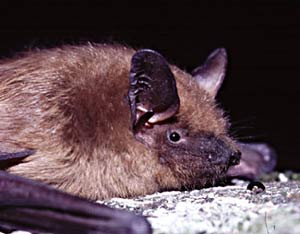
Perhaps you've noticed the proliferation of bat houses for sale and have wondered, like I have, whether these are just a fad. After looking into it, I'm convinced that bat houses are no joke, and that a thriving bat population is indeed in a gardener's best interest.
Each night, a colony of hundreds of bats consumes several hundred thousand insects, while colonies of millions of bats consume tons of insects. Their prey include pests such as flies, flying ants, June beetles, leafhoppers, mosquitoes, moths, and termites.
Almost all bats are nocturnal, insect-eating, and nearly blind. A few species feed primarily on fruit and nectar. Many are important pollinators of night-blooming flowers.
Unfortunately, more than half of the North American species are endangered, or nearly so. The most common reasons are habitat destruction and pesticides.
Here are a few things I've learned that will help you make your garden more hospitable to bats.
Making Friends With Bats
The first step is creating a favorable habitat. Flowers, such as dame's rocket (Hespereis matronalis), flowering tobacco (Nicotiana sylvestris), and evening primrose (Oenothera biennis), that release their scent at night attract the insects bats dine on. Herbs such as chives, lemon balm, marjoram, and mint are also attractive to insects. Bats regularly feed near sources of fresh water where insects abound, so if you live near a pond, stream, or lake, your chances of having bats visit are greater.
Of the 10 to 12 bat species that regularly use bat houses, the most common are the little brown and the big brown bats. Both are widespread throughout the United States except in parts of Texas and Florida, where the Brazilian free-tailed bat reigns. The pallid bat, named for its pale fur, is common in the West.
House Hunting (If You're A Bat)
To learn which bat houses are best, I checked with Mark Kiser of Bat Conservation International, a nonprofit organization that studies bats and their habits. The group's research is making it easier to learn how to attract bats, and it even certifies "bat approved" designs. Kiser offers the following considerations.
Location, location, location. Higher is better. Place the bat house at least 15 feet above the ground on a pole or outbuilding exterior. Mounting it on your home is not wise because bats support various mites, fleas, and insects (and very rarely, rabies) that you want to keep away from your house. Moreover, bats are messy. Trees aren't a good choice because predators like hawks and owls use them for cover.
Size. The ideal bat house size is 14 inches wide and 30 to 36 inches tall with four compartments or chambers that are 3/4- to 1-inch wide. Such a house (a condo really) accommodates about 200 bats.
Temperature. Bats prefer temperatures between 80o and 100oF. If you live in cool-summer regions (where July daytime highs average 80oF or less), place the house where it receives at least 10 hours of sun. Throughout most of the country, where daytime highs average less than 100oF, 6 hours of direct sunlight are recommended. In more southern latitudes where daytime temperatures often exceed 100oF, bat houses need no more than 3 to 4 hours of sun.
Color. The best color for a bat house is related to temperature control. Further north and in cool, coastal regions, paint houses black; in temperate regions, dark brown or gray; and in hot regions, use light, reflective colors. Apply three coats of flat exterior stain or latex paint.
Don't be discouraged if bats don't move in immediately. They often take up to two years to find the houses and relocate to them. If the house remains empty after two years, try another location. Once established, bats often return year after year.
Remember that bats are wild animals. If you treat them with respect, even a bit of encouragement, you'll enjoy a much less buggy summer.
Karen Dardick is a writer based in Los Angeles.
Photography by museum-bourges